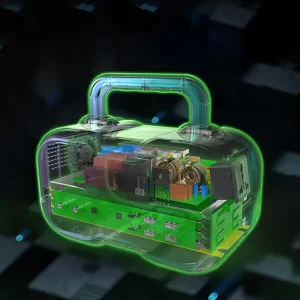In an era where connectivity and mobility are paramount, the 300W portable power station has emerged as an essential tool for various applications. Whether you’re an outdoor enthusiast, a digital nomad, or someone preparing for emergencies, these compact yet powerful devices offer a reliable source of energy when traditional power sources are unavailable. This article explores the benefits, challenges, and future potential of 300W portable power stations in meeting modern energy demands.

The Benefits of 300W Portable Power Stations
300W portable power stations provide a host of advantages that make them indispensable in today’s fast-paced world. Firstly, their compact and lightweight design makes them highly portable, allowing users to easily carry them on camping trips, road adventures, or even daily commutes. Despite their small size, these power stations pack a punch with a 300W output, capable of charging multiple devices such as smartphones, laptops, cameras, and even small appliances like mini-fridges or LED lights.
Another significant benefit is their versatility. Equipped with multiple output ports, including AC outlets, USB ports, and DC carports, these power stations can accommodate a wide range of devices and charging needs. Additionally, many models come with built-in solar panel compatibility, allowing users to recharge the power station using solar energy, which is both eco-friendly and cost-effective. This feature is particularly advantageous for those who spend extended periods in remote locations or want to reduce their carbon footprint.

Challenges in the Adoption of 300W Portable Power Stations
While 300W portable power stations offer numerous benefits, there are several challenges that need to be addressed to enhance their adoption and usability. One of the primary challenges is the initial cost. High-quality portable power stations can be relatively expensive, which may deter some potential users. However, as technology advances and production scales up, prices are expected to become more affordable.
Another challenge is the limited energy capacity. Although 300W is sufficient for many small devices and short-term use, it may not be adequate for more power-intensive applications or extended periods without recharging. Users must carefully manage their power consumption and may need to invest in additional solar panels or backup power sources for longer trips or emergencies.
Additionally, the efficiency of recharging methods can vary. While solar panels offer a sustainable way to recharge the power station, their effectiveness depends on weather conditions and sunlight availability. Users in cloudy or shaded environments may experience slower charging times, necessitating alternative recharging options like AC wall outlets or car chargers.

The Future of 300W Portable Power Stations
The future of 300W portable power stations looks promising, driven by continuous technological advancements and growing demand for portable energy solutions. Innovations in battery technology, such as the development of solid-state batteries, are expected to enhance energy density, reduce weight, and improve overall performance. These advancements will enable longer usage times and faster recharging, making portable power stations even more practical and convenient.
Moreover, the integration of smart technology and IoT (Internet of Things) capabilities is set to revolutionize the user experience. Smart power stations can offer real-time monitoring, remote control, and energy management features through mobile apps, allowing users to optimize their power usage and extend the lifespan of their devices. This level of control and convenience will make portable power stations more appealing to a broader audience.
The 300W portable power station represents a versatile and reliable solution for modern energy needs. Its portability, versatility, and compatibility with renewable energy sources make it an invaluable tool for outdoor enthusiasts, digital nomads, and emergency preparedness. While challenges such as cost and limited energy capacity exist, ongoing technological advancements and increased awareness are poised to drive the adoption and improvement of these devices. As we continue to prioritize mobility and sustainability, 300W portable power stations will play a crucial role in meeting our evolving energy demands and shaping a more connected and eco-friendly future.






